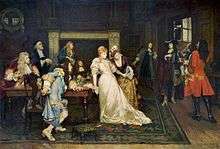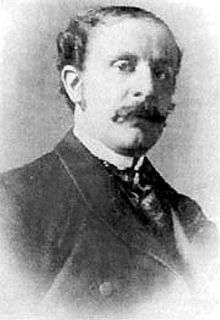Henry Gillard Glindoni
Henry Gillard Glindoni (London 1852 – 20 November 1913 Romford, Essex) was a British painter noted for history and historical genre.

Life
Glindoni was born in Kennington Lane in London, one of a family of five orphans. His father Francis was known by his middle name Robert and was born about 1799 in Dublin. Initially Robert was a singer and songwriter. He turned to scene painting when his voice failed him. His ditty ‘The literary Dustman’ was published in 1832 and he financed the Colosseum Diorama and Exhibition Space, Regents Park. He was responsible for the enormous diorama “London by Night”, the Colosseum's opening attraction. Robert was married twice, first in 1820 to Mary Ann Adams who died in 1827 and then to Sarah Harris in 1829. Sarah died in 1849 so Robert was left to bring up his children alone. The Colosseum closed in 1864 just 2 years before Robert's death in 1866. He was buried at Kensal Green London.
In 1871, a year before Henry began exhibiting at the Royal Academy he was living with his uncle Frederick Young and aunt Sarah in Kentish Town.
Henry is listed as a landscape painter. No doubt Henry leaned some of his skills from his grandfather, helping him paint scenes in the theatre. Ten years later Henry is married to Ruth, living in Chelsea and has a six-month-old daughter Esther.
At the turn of the century Henry moved to Chadwell Heath, in 1901 he was living at The Studio, Mill Lane, later buying the New Villa on Whalebone Lane with his wife and daughter, now a school teacher, his mother in law Ann Wheeler, sister in law Harriet Cave and niece Alice Cave.
Henry Gillard Glindoni R.B.A., A.R.W.S died on 20 November 1913. He had 79 paintings shown at the Royal Society of British Artists, elected a member in 1879, over 40 works seen at the Royal Watercolour Society, exhibited at the Royal Institute of Painters in Oil, the Royal Etchers Society, at Manchester City Art Gallery, Liverpool's Walker Art Gallery.

He was drawn into the world of theatre and became a scenery paint further augmenting his finances by sketching the actors with whom he came in contact. He also tried his hand at porcelain painting. Encouraged to study art, he attended Maurice's Working Men's College and the Castle Street School of Art after encouragement from fellow actors to study art.
Glindoni's speciality was that of 17th and 18th century costume and he was noted for his paintings of Cardinals. He settled in Chadwell Heath some time after 1891, living in a new cottage which still exists at the corner of Mill Lane and Whalebone Lane North, New Villa.
Glindoni frequently exhibited between 1872 and 1904, at the Royal Academy, Royal Institute of Oil Painters, Royal Society of Painter-Etchers and Engravers, Old Water Colour Society, the Society of British Artists in London, and the Royal Society of Artists in Birmingham. He was accepted as a full member of the Royal Society of British Artists in 1879 and an associate member of the Royal Watercolour Society in 1883.
It is well known fact the I in The name was taken off due to a family feud after seeing the family tree which has been tracked back many years and that the name comes from Pisa in Italy but going back to the 1600s there is a Freeme Riley in the family tree.
He is buried in st George's church cemetery in Romford along with his wife Ruth. His work may be seen at Valence House Museum.[1][2][3]
References
- "Galerie Michael". Archived from the original on 2011-12-10. Retrieved 2011-12-13.
- Wood, Christopher, Dictionary of Victorian Artists, Woodbridge, 1971
- Johnson, J., and Anna Gruetzner, Dictionary of British Artists 1880-1940, Woodbridge, 1980